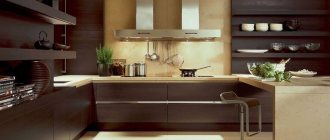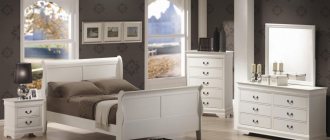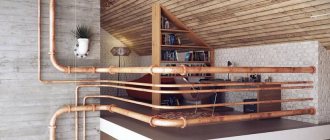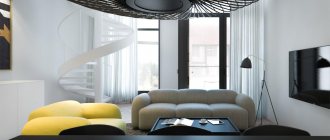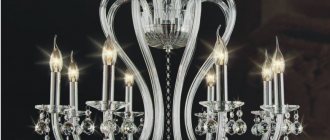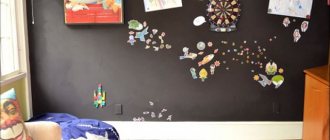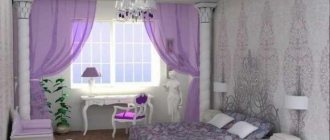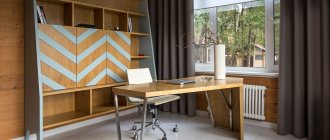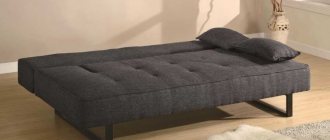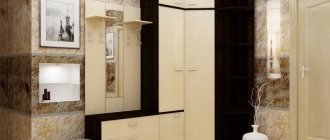The word “stained glass” immediately brings to mind the image of the central windows of masterpieces of European architecture - Gothic cathedrals. Transmitting sunlight and filling the interior space with a play of colors, huge decorative glass compositions painted the cold stone of the temples with bright reflections.
This decorative element has always been expensive due to the uniqueness of the craftsmen’s work, the complexity of selecting fragments, and the length of the joining and soldering process. Today, stained glass windows in the interior are available to everyone who wants to add a touch of non-triviality to the design of their home. Thanks to modern technologies, their production has become easier, and imitations, which are in no way inferior in visual effect to their classic counterparts, are much cheaper.
Antiquity and modernity: types of stained glass
The main options for stained glass differ in the method of their manufacture:
- a composition of fragments of colored glass connected by metal bindings;
- fusing painted glass pieces onto a base;
- film stained glass over solid glass;
- painted (filled) stained glass: after applying the outline, the transparent surface is covered with paints, the result is a drawing that copies the original stained glass technique.
Classic stained glass is always unique. This is the artist's creation in a single copy; it cannot be stamped like silicone molds. Modern options that imitate compositions made of colored glass by gluing transparent colored films onto the base, or applying colorful layers and borders (analogues of metal bindings) can be put into production. This is a fundamental difference that affects the cost and artistic value of the glass panel.
Seamless stained glass: glass does not cut, but melts
Seamless stained glass is created by high-temperature processing of a pattern from small colored fragments laid out on a single glass sheet. The individual layers are soldered and the metal contours are filled with heated glass, which makes it possible to obtain a large stained glass canvas of sufficient strength. There are several techniques used to produce this type of stained glass. They differ in the metal used for the contours or its absence, and with the help of etching (acid treatment of different areas according to the sketch), it is possible to form patterns from matte and transparent elements of varying depths. Using the etching method, you can create a unique piece of decor for your own home with your own hands, the main thing is to follow the safety rules.
Stacked stained glass compositions: a classic that evokes admiration
Stacked stained glass is a connection of glass by inserting it into a metal frame and then soldering it. This is the method used to make stained glass windows that decorate castles and medieval churches. This is the most ancient, labor-intensive technology, which has its drawbacks during creation and installation:
- preliminary cutting of glass of required sizes;
- the need for a perfect fit of metal (lead) bindings and glass fragments;
- significant width of the H-shaped profile;
- heavy weight;
- impossibility of creating a rounded surface (only flat objects).
An improved typesetting stained glass window is a product made in the American Tiffany technique. This is a composition of painted glass pieces assembled into a single whole with copper tape and tin soldering. Refusal of rigidly fixed bindings allows you to use fragments of the smallest size, create convex-concave shapes, and repeat the smooth lines of sketches.
Relief stained glass windows: volume plays the main role
When developing an interior design project, decorating furniture, door panels, i.e. objects that are often in front of the eyes of apartment owners, the use of relief stained glass is especially effective. Creating additional volume allows you to make each decorative element a “box with a secret”: the facade is visually transformed depending on the time of day, general lighting, and attracts attention.
Obtaining a stained glass relief is possible in 2 cases:
- when removing a chamfer (bevel) along the perimeter of glass elements;
- when using voluminous, faceted, polished glass inserts in the general plane of the composition.
The cut brings ordinary glass closer in appearance to precious stones, the edges shine from every ray of light, the copper border adds a golden shimmer and any furniture door becomes a door to Aladdin’s treasury.
Film version of stained glass: more accessible, simpler, more economical
The simplest manufacturing technology is film stained glass, but it looks no worse than its textured counterparts. A home craftsman can make this decorative element with his own hands using adhesive film. Important points in the process are: development of a design taking into account the basics of technology, careful preparation of the surface, accuracy when applying colored fragments, if we are talking about individual parts of the composition.
Manufacturers of film materials have gone further along the path of facilitating the work of “homemade” ones - they offer a wide range of ready-made self-adhesive designs in different formats. The advantages of stained glass film are obvious: it does not fade under the influence of ultraviolet radiation, can protect households in case of accidental glass breakage, ideally reproduces the effect of stained glass glazing, and can be easily replaced if the design seems irrelevant after a while.
What types of stained glass are there?
Attic decorated with stained glass panoramic glazing
The technique of making stained glass has changed greatly over time, but in some cathedrals and ancient castles you can still find compositions in the classical style. Modern technologies make it possible to create more sophisticated designs and elegant compositions. Ancient stained glass windows are distinguished by a certain roughness, which is often invisible in photographs of these architectural monuments due to the high location of the windows in cathedrals and castles.
Stained glass will not go unnoticed and will deprive the most ordinary interior of an apartment or office of banality.
At the moment, several types of stained glass designs have become widespread.
Stained glass windows in the Tiffany style are distinguished by grace and lightness. According to the technology for their production, colored glass pieces of the desired shape are wrapped around the perimeter with copper film, and then fastened together with special solder. The thinnest lines are applied with stained glass paint. The finished composition is encased in a profile, which gives it strength, and the seams are covered with a patina.
Using stained glass you can solve the problem of a dark hallway
Stained glass "Fusing" has several stages of production. First, a design is applied to the glass, which is then laid out with colored pieces of glass. The finished composition is baked in an oven so that the colored glass penetrates into the base. The pattern is slightly embossed, and the design is quite thick.
Stained glass doors correctly selected in color and transparency will make the hall brighter and more comfortable
Stained glass mosaic is made from colored modules. Several pieces of glass are connected to each other and placed in separate frames. Ready-made modules are inserted into a single housing and mosaic glass is obtained.
Stained glass window in the bathroom in the form of a mosaic
Etched stained glass windows are made by burning a design onto glass with a special acid. The result is a fairly deep outline, which is then painted. This method has become widespread due to a simpler manufacturing method compared to classic stained glass or Tiffany style.
Part of the drawing can be left without coloring
Another accessible way to obtain a stained glass pattern is to decorate transparent glass with special paints and then cover it with a fixing layer. Such pseudo-stained glass windows are often inserted into the doors of sliding wardrobes.
A window in the form of a narrow light belt in the middle of the wall seems to expand a small room and sufficiently transmits sunlight
Film stained glass is made by gluing onto glass a film with a pattern already applied to it. This option is quite common due to its low cost, which allows you to decorate windows or doors without any special material costs.
The simplest and most economical way to decorate a window with stained glass is film stained glass
Film stained glass window in Tiffany style
Stained glass in the interior: a tour of styles
Today, stained glass technologies make it possible to create both replicas of antique products and modern compositions that can become a real interior decoration. The prerogative of the customer is to decide on the style, the rest will be done by professionals.
| Style | Gothic | Modern | Tiffany | Modern classic | Minimalism |
| Primary colors | Rich tones: blue, blood red, emerald, yellow | Mint, cobalt, milky pearl, pink, purple | Soft shades: autumn yellow, orange, muted grass, brown, blue | Color variations are infinitely expanded thanks to artificial additives | Monochrome or contrast |
| Distinctive features | Lead bindings, glass fragments of geometric shapes | Smooth lines, use of floral patterns (irises, poppies, lotuses, ivy) | Rounded shapes, detailing, special “opal” glass | Possibility of interspersing other materials, not limited in scale, without braids | Clean lines, big splashes of color |
| Application examples | Volumetric compositions, windows, filling door panels | Interior partitions, glazing of window transoms | Lampshades, chandeliers, ceiling lamps, vases, boxes, trays | Wall partitions, shower walls | Decorative interior elements, light panels, wall inserts |
No. 10. Stained glass for mirror
You can cover a mirror surface with stained glass, either completely or partially. In the first case, we will get an interesting decoration for the interior, as well as the opportunity to visually expand the space. The mirror can be used for its intended purpose if only its edges are decorated with stained glass. Typically, sandblasted stained glass is used for decoration; film or painted stained glass is also suitable.
Stained glass window: everything behind the glass changes color
Depending on the artistic task set and the scale of the glazing, stained glass windows can completely cover window openings or decorate part of them. Interior designers recommend, when selecting room decoration, to coordinate the glass pattern with the elements of inlaid parquet, enhancing the overall style impression. Volumetric stained glass panels look especially impressive in country houses with a second light - the rays of the sun penetrate inside through a kaleidoscope of fragments, creating an intriguing play of light and color, making the interior of the main room unique.
To mark the center of the house, it is necessary to use volumetric color spots, small pieces, similar to a Harlequin costume, that will split up a large space.
Types of ceilings
The main types of stained glass ceiling structures.
Hanging
They are made on a special metal frame, and then attached to the ceiling using pendants.
Cassette
They are pre-made tiles that are inserted into the ceiling frame.
The photo shows a cassette-type stained glass ceiling.
Tensioners
Suitable for stained glass inserts that are mounted on a metal frame of a certain shape.
Ceiling lamp
A round type of ceiling that can have absolutely any size. The ceiling stained glass window is a very bright decorative element.
Combined
Stained glass in combination with plasterboard is very popular in the design of various interiors. Stained glass elements make it possible to lighten and embellish gypsum plasterboard structures.
The photo shows a combined plasterboard ceiling with a stained glass element.
Caisson
Such models with decoratively designed recesses look very impressive and creative.
Stained glass door leads to a fairy tale
Decorative inserts made of colored glass can decorate doors of both classic and modern design; the main difference is the pattern. Glazing opening options:
- minimal (narrow long insert);
- maximum (full glass door);
- intermediate (the top of the door leaf, its half, a significant part).
A glass door leaf without a solid base can only be turned into seamless etched, sandblasted, film stained glass or a painted version; here the main criterion is safety of use. But the classic door will withstand any option - its strength characteristics are sufficient for a type-setting stained glass element.
A special decoration of a large house can be stained glass partitions - double hinged doors built into the walls with glass inserts. Such designs easily combine several rooms, creating a suite of halls for receiving a large number of guests.
Functionality of stained glass
Stained glass windows can perform a variety of tasks:
- regulate the intensity of sunlight;
- prevent the penetration of prying eyes;
- divide the space inside the house into certain zones;
- just decorate the interior.
The functional tasks of stained glass windows affect their placement in the house:
- External stained glass windows must be transparent, otherwise sunlight through such windows and doors will not enter the house in sufficient quantities. At the same time, if a stained glass window replaces curtains or blinds, part or all of the glass must be painted over, otherwise the sun and the views of neighbors will disrupt the cozy atmosphere in the room.
- Frosted glass or mirror inserts can be used in interior stained glass windows.
- Ceiling stained glass windows, which are often used in attics, must be very durable, because the windows have to withstand the load not only from the wind, but also from precipitation (rain and snow).
- Mobile stained glass partitions are often framed in aluminum frames. Do not forget about the fragility of glass - such interior details must be used with extreme caution.
- There are also false windows that are placed in niches or simply on the walls - these structures should ensure the visibility of a window where there is actually none. And such false windows also serve as interior decoration, because stained glass is rarely inferior in beauty to the most spectacular painting.
Colored glass ceiling
Modern versions of stained glass windows are light and durable, which allows them not only to fill openings in the vertical structure of a house, but also to attach them to horizontal surfaces. Instead of the often used ceiling stucco in combination with a cascading chandelier, stained glass glazing of the ceiling is possible, which can emphasize the given interior style.
The advantages of this technique are obvious:
- Light sources are hidden;
- Electrical wiring is removed between the main ceiling and the decorative one;
- The height of the room decreases slightly;
- Possibility of illuminating different sectors of a glass composition, creating several design options instead of one;
- Selecting a stained glass image that matches the overall interior design.
Application of stained glass
Stained glass is rarely used for loft or high-tech, but even in these styles you can choose suitable patterns to order.
In the work office (zone), clear forms of geometric motifs with silver, chocolate, sand, and cognac shades are ideal. The darkest tone of the pattern itself should be half a tone lighter than its edges.
It is better to choose abstract stained glass windows for living spaces. This could be a door, a niche or windows that continue the overall design solution or vice versa, which is a contrast, a bright accent in the design.
In the kitchen, stained glass windows instead of wooden doors are an excellent design option even in small rooms. The facades of any cabinet, tables and bedside tables, an impressive stained glass apron, imitation tiles.
This will become the main decor of the kitchen, where the hostess and the whole family spend so much time. To select a pattern, you need to take into account the color scheme, image size, and placement.
Even in the kitchen there should be harmony; the stained glass window should be combined with kitchen furniture, decoration and other decorative items.
A wardrobe that performs many functions in a hallway, bedroom or recreation area in a modern style or a classic of any tone can be made a masterpiece if you decorate all its doors with one stained glass window.
Decorative elements in stained glass technique: accompaniment with light
Stained glass windows of the “flaming Gothic” looked most impressive when the sun penetrated into the premises, and the pure colors obtained thanks to natural dyes glowed and delighted with their fullness. Today, you can use all options for artificial lighting, creating the light saturation that is necessary according to a given decorative scenario.
Electricity allows you to place illuminated stained glass paintings in places where there is no natural light (corridor, hall). Slots in the walls filled with luminous stained glass windows create the illusion of sunshine, which is extremely necessary for a person’s psychological health.
A bright accent of the dining room can be a dining table, where the stained glass canvas is framed by wood. Backlighting is also required here, allowing you to see all the richness of rich colors. A fireplace screen combining metal and painted glass, letting in the glare of a live fire, will bring a similar effect to the atmosphere of the living room.
No. 2. Window stained glass
Most often, stained glass is used to decorate windows. Such a solution allows you to transform the interior, because sunlight will be refracted and give non-standard lighting to the room. If the windows face north, it is better to choose light colors for stained glass. Stained glass windows are best suited for bedrooms and other rooms intended for relaxation.
Stained glass on a window can serve not just as decoration, but also become a purely practical solution when it is necessary to hide a room from the prying eyes of strangers. That is why stained glass windows often become decorations in bathrooms. Some stained glass windows hide not the best view from the window.
The use of stained glass in furniture: antiques and modern interpretation
Furniture items with stained glass inserts will be appropriate in any room of the house: kitchen, bedroom, dining room, living room. The main thing is that they match the interior.
- A sideboard, showcase, buffet will place tableware, glass and crystal behind stained glass doors;
- A wardrobe, where the central door is filled with a stained glass insert, and the outer ones are made of noble wood, will decorate a large bedroom;
- A stained glass screen, consisting of solid panels or decorated with colored glass ornaments in the upper part, will separate a private relaxation area in a small studio;
- The facades of the upper cabinets of the kitchen set, decorated with stained glass windows, will add a touch of cozy antiquity to the atmosphere of the kitchen.
Having chosen a set with stained glass facades, make sure that the apron tiles above the work surface are neutral and do not distract attention from the main colorful accent.
History of stained glass
The first stained glass windows were created from small pieces of glass held together by strips of metal, the remains of which were found in Egypt and are over 5,000 years old. The reason for such an intricate technology is explained by the fact that humanity has not yet been able to produce glass of the required area.
In Italy, instead of glass, plates of translucent minerals were inserted into the windows: selenite, alabaster - this protected the rooms from the hot sun and created a mysterious penumbra. Soon they learned to paint glass blue and red, and much later - yellow. Stained glass became an integral part of the architecture of Gothic cathedrals and was subsequently associated for a long time with majestic narrative paintings made of colored glass. The bright rays of the sun broke into myriads of colored fragments, filling the sparse interior of the cathedrals with an unearthly light.
Stained glass door to the spirit
Since then, bursts of fashion for stained glass in the interior have been replaced by oblivion, and new areas of application have been found for them. Stained glass began to decorate not only windows, but also furniture, doors, lamps, remaining an expensive decor for palaces and church cathedrals.
Nowadays there is a surge in interest in stained glass, and it is associated with at least two reasons:
- with a high degree of unification in the construction of buildings and interior decoration;
- with advances in stained glass technology.
Let's consider what traditional and new technologies are used by modern stained glass manufacturers, and what application they find in decorating modern interiors.
Stained glass front door
Choice is based on reality
The designer is able to determine which stained glass decor option will suit the existing room, but the final word belongs to those who will live surrounded by colored glass. If your country house looks like a castle, use a classic stained glass window. If you want stained glass splendor, and small children and pets are frolicking in the apartment, stop at analogue options. With a minimum of living space, decorate your home with several accessories using stained glass technology. The pleasure of the play of bright colors and light is guaranteed in any case.
Photos of stained glass windows in the interior
Related publications
- Read
Wooden windows: what are their advantages
- Read
Installation of blinds on plastic windows
- Read
How to insulate plastic windows for the winter
- Read
DIY anti-cat mesh for windows
- Read
Installation of roller blinds on plastic windows
- Read
